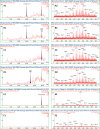Isolation of Cottonseed Extracts That Affect Human Cancer Cell Growth
- PMID: 29993017
- PMCID: PMC6041348
- DOI: 10.1038/s41598-018-28773-4
Isolation of Cottonseed Extracts That Affect Human Cancer Cell Growth
Abstract
Cottonseeds are classified as glanded or glandless seeds depending on the presence or absence of gossypol glands. Glanded cottonseed has anticancer property and glandless cottonseed was reported to cause cancer in one animal study. It is important to investigate the effect of bioactive components from cottonseeds. Our objectives were to isolate ethanol extracts from cottonseeds and investigate their effects on human cancer cells. A protocol was developed for isolating bioactive extracts from seed coat and kernel of glanded and glandless cottonseeds. HPLC-MS analyzed the four ethanol extracts but only quercetin was identified in the glandless seed coat extract. Residual gossypol was detected in the glanded and glandless seed kernel extracts and but only in the glanded seed coat extract. Ethanol extracts were used to treat human cancer cells derived from breast and pancreas followed by MTT assay for cell viability. Ethanol extracts from glanded and glandless cottonseed kernels and gossypol significantly decreased breast cancer cell mitochondrial activity. Ethanol extract from glanded cottonseed kernel and gossypol also significantly decreased pancreas cancer cell mitochondrial activity. These results suggest that ethanol extracts from cottonseeds, like gossypol, contain anticancer activities.
Conflict of interest statement
The authors declare no competing interests.
Figures






References
-
- Tharp, W. H. In Cottonseed and Cottonseed Products (Bailey, A. E., ed.), pp. 117–156, Interscience, New York (1948).
Publication types
MeSH terms
Substances
LinkOut - more resources
Full Text Sources
Other Literature Sources
Medical

